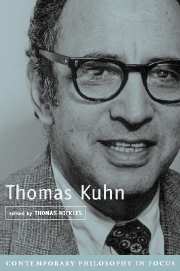Book contents
- Frontmatter
- Contents
- Contributors
- Preface
- Introduction
- 1 Kuhn and Logical Empiricism
- 2 Thomas Kuhn and French Philosophy of Science
- 3 Normal Science and Dogmatism, Paradigms and Progress: Kuhn ‘versus’ Popper and Lakatos
- 4 Kuhn's Philosophy of Scientific Practice
- 5 Thomas Kuhn and the Problem of Social Order in Science
- 6 Normal Science: From Logic to Case-Based and Model-Based Reasoning
- 7 Kuhn, Conceptual Change, and Cognitive Science
- 8 Kuhn on Concepts and Categorization
- 9 Kuhn's World Changes
- 10 Does The Structure of Scientific Revolutions Permit a Feminist Revolution in Science?
- Selected References in English
- Index
- References
4 - Kuhn's Philosophy of Scientific Practice
Published online by Cambridge University Press: 07 December 2009
- Frontmatter
- Contents
- Contributors
- Preface
- Introduction
- 1 Kuhn and Logical Empiricism
- 2 Thomas Kuhn and French Philosophy of Science
- 3 Normal Science and Dogmatism, Paradigms and Progress: Kuhn ‘versus’ Popper and Lakatos
- 4 Kuhn's Philosophy of Scientific Practice
- 5 Thomas Kuhn and the Problem of Social Order in Science
- 6 Normal Science: From Logic to Case-Based and Model-Based Reasoning
- 7 Kuhn, Conceptual Change, and Cognitive Science
- 8 Kuhn on Concepts and Categorization
- 9 Kuhn's World Changes
- 10 Does The Structure of Scientific Revolutions Permit a Feminist Revolution in Science?
- Selected References in English
- Index
- References
Summary
The opening sentence of The Structure of Scientific Revolutions is often thought to be prophetic. Kuhn proclaimed that “history of science … could produce a decisive transformation in the image of science by which we are now possessed” (1970, p. 1). In the decade or so after the book was published in 1962, the dominant philosophical conception of science, logical empiricism, was indeed substantially transformed. Moreover, although Kuhn's book at the time was only one among a half dozen prominent challenges to logical empiricism, it has in retrospect become the symbol for its own revolution, marking a transition to a postempiricist era in the philosophy of science. Citations of Kuhn are now ubiquitous in various contrasts between the supposedly bad old days and some more enlightened present conception of science.
Proclamations of revolution are often succeeded by revisionist debunking. That fate may well befall Kuhn's book. In the past decade or so, a number of scholars have convincingly called attention to important continuities between Kuhn's book and the work of his logical empiricist predecessors. Others note that Kuhn and his most sympathetic readers have repudiated the most radical-sounding claims associated with the book. In a still different vein, one scholar has argued that Kuhn's book was reactionary rather than revolutionary: Fuller (1999) claims both that Kuhn aimed to insulate science from public scrutiny and democratic control, and that, contrary to its public image, the philosophical and social scientific work most influenced by Kuhn has had just that effect.
Information
- Type
- Chapter
- Information
- Thomas Kuhn , pp. 101 - 121Publisher: Cambridge University PressPrint publication year: 2002
References
Accessibility standard: Unknown
Why this information is here
This section outlines the accessibility features of this content - including support for screen readers, full keyboard navigation and high-contrast display options. This may not be relevant for you.Accessibility Information
- 11
- Cited by
